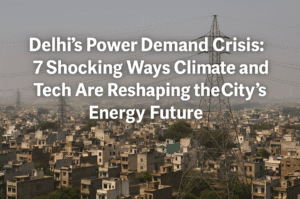Delhi’s Power Demand Crisis: 7 Shocking Ways Climate and Tech Are Reshaping the City’s Energy Future
Delhi’s peak power demand surged to 6,015 MW in April 2025, marking the highest April tally in three years amid escalating heatwaves. This follows 2024’s record-breaking 8,656 MW summer peak, with forecasts predicting a first-ever 9,000 MW demand in 2025 as temperatures climb. Distribution companies like BSES and Tata Power-DDL are leveraging advanced solutions—AI-driven demand forecasting, interstate power-sharing pacts, and 2,100 MW of green energy—to stabilize supply. BSES zones met demands of 2,590 MW and 1,290 MW, while Tata Power handled 1,817 MW in northern Delhi through upgraded grids.
The crisis mirrors nationwide strain, with heatwaves threatening health, labor productivity, and energy security. Long-term resilience hinges on expanding renewables, adaptive urban design, and dynamic pricing to curb peak loads. Delhi’s struggle underscores the urgent need for cities to fuse climate adaptation with tech innovation, balancing growth and sustainability in an era of extreme weather.

Delhi’s Power Demand Crisis: 7 Shocking Ways Climate and Tech Are Reshaping the City’s Energy Future
As temperatures soar, Delhi’s electricity infrastructure faces unprecedented strain. On April 28, 2025, the capital recorded a peak power demand of 6,015 MW—the highest for April in three years. This milestone underscores a worrying trend: rising heatwaves and urban growth are pushing energy systems to their limits.
Historic Trends and Future Projections
Delhi’s power consumption has surged steadily, with 2024’s peak hitting 8,656 MW. Authorities now predict summer 2025 could breach 9,000 MW for the first time—a 4% year-on-year increase. This spike aligns with India’s broader climate challenges, where longer, hotter summers have become the norm.
Behind the Scenes: How Discoms Are Coping
To avert crises, distribution companies (discoms) are deploying innovative strategies:
- BSES, serving South, West, East, and Central Delhi, met peaks of 2,590 MW and 1,290 MW in its zones. It now leans on AI and machine learning to forecast demand with 98% accuracy, enabling proactive grid management.
- Green Energy Integration: Over 2,100 MW of renewable power, including solar and wind, supplements traditional sources, reducing reliance on fossil fuels during critical periods.
- Inter-State Power Banking: Agreements with states like Himachal Pradesh and Uttarakhand provide up to 500 MW of hydroelectric power during peak summer months.
Meanwhile, Tata Power-DDL, serving North Delhi, managed a record 1,817 MW demand this season through upgraded infrastructure and real-time monitoring.
The Climate-Energy Nexus
Delhi’s plight mirrors a national crisis. The IMD’s warnings of prolonged heatwaves across Punjab, Haryana, and Rajasthan highlight the dual burden on energy grids and public health. Beyond infrastructure, extreme heat jeopardizes workers in sectors like mining and manufacturing, as noted in recent reports of heat-related productivity losses.
The Road Ahead: Sustainability Meets Innovation
While discoms’ preparedness is commendable, long-term solutions demand systemic shifts:
- Expanding Renewable Capacity: Delhi aims to source 25% of its energy from renewables by 2027, per its Solar Policy. Decentralized solar installations could ease grid pressure.
- Demand-Sensitive Pricing: Dynamic tariffs during peak hours might incentivize off-peak usage, flattening demand curves.
- Urban Planning: Green buildings, cool roofs, and tree cover can reduce urban heat island effects, indirectly lowering energy needs.
A Call for Collaborative Action
Delhi’s energy crunch is a microcosm of global cities grappling with climate change. While AI and green investments offer short-term relief, policymakers must prioritize adaptive infrastructure, public awareness, and cross-state collaboration. As temperatures climb, the capital’s ability to balance growth with sustainability will set a precedent for others to follow.
You must be logged in to post a comment.